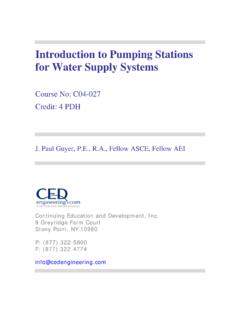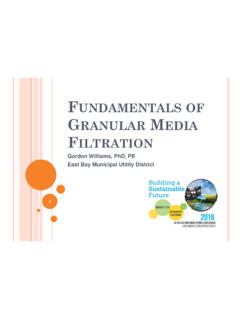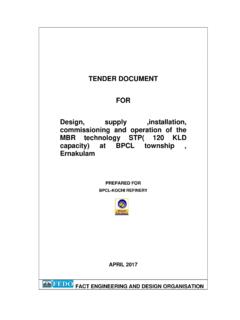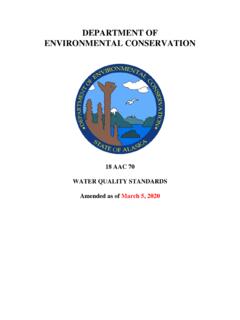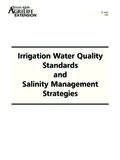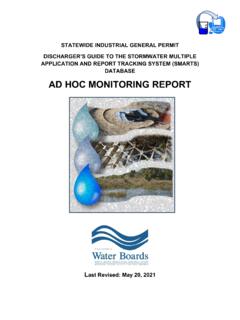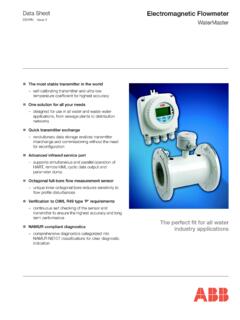Transcription of Introduction in the technical design for anaerobic ...
1 Heinz-Peter MangIntroduction in the technical design for anaerobic treatment systemsSanitary biogas systems .. are efficient, hygienic and ecologically sound wastewater treatment units with the additional benefits of energy production and an effluent of high nutrient content.. can be combined with any type of (low-)flush toilet (including pour flush) and their effluent can be used directly for fertiliser application and irrigation.. can be followed by constructed wetlands or other aerobic tertiary treatment to allow other forms of reuse of the effluent for car-washing, toilet flushing or outdoor cleaning purposes. The treatment of organic solid kitchen and garden wastes can also be integrated into the concept to increase biogas production and reduce household waste. Unlike septic tank systems, sanitary biogas units do not require frequent sludge which are influencing the digestion process are Feedingcarbon Mix fresh and old materialinoculation Waterphysical Temperatureconditions pH valuemilieu Retention timetime to actBIOGASHow does anaerobic treatment of solids differ from that of wastewaters ?
2 How do we achieve high SRT in anaerobic treatment system ? anaerobic treatment of high solids such as animal manure, biological sludge, nightsoil, etc. is commonly known as anaerobic digestion and is carried out in airtight container known as anaerobic digester (AD). AD is usually continuous flow stirred tankreactor (CFSTR) for which HRT and SRT isnearly the same the ratio of SRT/HRT = 1. design is based on volatile solids (VS) loading rateAnaerobic treatment of wastewaters requires long SRT to achieve better treatment efficiency The ratio of SRT/HRT ~ 10-100 The high ratio allows the slow growing methanogens to remainin the reactor for longer of anaerobic energy requirement as no aeration is kWh energy is needed for every 1 kg of COD removal by aerobic generation in the form of methane kWh energy is produced for every 1 kg of COD removal by anaerobic process3. Less biomass (sludge) generationAnaerobic process produces only 20% of sludge that of aerobic processSoluble BOD1 kgAerobic processCO2+ COD1 kgAnaerobic processCH4gas> kgNew biomass< kg4.
3 Less nutrients (N & P) requirementLower biomass synthesis rate also implies less nutrients requirement : 20% of aerobic 5. Application of higher organic loading rateOrganic loading rates of 5-10 times higher than that of aerobic processes are possible6. Space savingApplication of higher loading rate requires smaller reactor volume thereby saving the land to transform several hazardous solvents including chloroform, trichloroethylene and trichloroethane to an easily degradable formLimitations of anaerobic processes1. Long start-up timeBecause of lower biomass synthesis rate, it requires longer start-up time to attain a biomass Long recovery timeIf an anaerobic system subjected to disturbances either due to biomass wash-out, toxic substances or shock loading, it may take longer time for the system to return to normal operating Specific nutrients/trace metal requirementsAnaerobic microorganisms especially methanogens have specific nutrients Fe, Ni, and Co requirement for optimum More susceptible to changes in environmental conditionsAnaerobic microorganisms especially methanogens are prone to changes inconditions such as temperature, pH, redox potential, Treatment of sulfate rich wastewaterThe presence of sulfate not only reduces the methane yield due to substrate competition but also inhibits the methanogens due to sulfide effluent quality of treated wastewaterThe minimum substrate concentration (Smin)
4 From which microorganisms are able togenerate energy for their growth and maintenance is much higher for anaerobic treatment system. Owing to this fact, anaerobic processes may not able to degradethe organic matter to the level meeting the discharge limits for ultimate Treatment of high protein & nitrogen containing wastewaterThe anaerobic degradation of proteins produces amines which are no longer be degraded anaerobically. Similarly nitrogen remains unchanged during anaerobic treatment. Recently, a process called ANAMMOX ( anaerobic AMMonium OXididation) has been developed to anaerobically oxidize NH4+to N2in presence of + + NO2-N2+ 2H2O1NH4+ + + + + + + + Comparison between anaerobic and aerobic processes anaerobic AerobicOrganic loading rate:High loading rates:10-40 kg COD/m3-dayLow loading kg COD/m3-day(for high rate reactors, AF,UASB, E/FBR)(for activated sludge process)Biomass yield:Low biomass kg VSS/kg CODHigh biomass kg VSS/kg COD(biomass yield is not constant but depends on types of substrates metabolized)(biomass yield is fairly constant irrespectiveof types of substrates metabolized)Specific substrate utilization rate:High rate: kg COD/kg VSS-dayLow rate: kg COD/kg VSS-dayStart-up time:Long start-up: 1-2 months for mesophilic: 2-3 months for thermophilicShort start-up: 1-2 weeksAnaerobic AerobicSRT.
5 Longer SRT is essential to retain the slowgrowing methanogens within the reactor. Microbiology: anaerobic process is multi-step process and diverse group of microorganisms degrade the organic matter in a sequential process is mainly a one-species phenomenon. Environmental factors:The process is highly susceptible to changes in environmental of 4-10 days is enough in case of activated sludge process. The process is less susceptible to changes in environmental much methane gas can be generated through complete anaerobic degradation of 1 kg COD at STP ?Step 2: Conversion of CH4mass to equivalent volumeBased on gas law, 1 mole of any gas at STP (Standard Temperature and Pressure) occupies volume of >1 Mole CH4~ L CH4=>16 g CH4 ~ L CH4=>1 g CH4 ~ = L CH4 ----------(2)Step 1: Calculation of COD equivalent of CH4CH4+2O2------------------>CO2+ 2H2O16 g64g=> 16 g CH4~ 64 g O2(COD)=>1 g CH4~ 64/16 = 4 g COD------------(1)Step 3: CH4generation rate per unit of COD removedFrom eq.
6 (1) and eq. (2), we have,=>1 g CH4~4 g COD ~ L CH4=>4 g COD~ L CH4=>1 g COD ~ = LCH4or1 Kg COD~ m3CH4-----------(3)complete anaerobic degradation of 1 Kg COD m3CH4at dioxideCOMPLEX ORGANIC MATTERSP roteinsCarbohydratesLipidsAmino Acids, SugarsFatty Acids, AlcoholshydrolysisINTERMEDIARY PRODUCTS(C>2; Propionate, Butyrate etc)acidogenesisAcetateHydrogen, Carbon dioxideacetogenesisOrganics Conversion in anaerobic Systemmethanogenesis7228 Essential conditions for efficient anaerobic treatment Enough nutrients (N & P) and trace metals especially, Fe, Co, Ni, etc. COD:N:P = 350:7:1 (for highly loaded system) 1000:7:1 (lightly loaded system) Avoid excessive air/O2exposure No toxic/inhibitory compounds present in the influent Maintain pH between Sufficient alkalinity present Low volatile fatty acids (VFAs) Temperature around mesophilic range (30-38 oC) SRT/HRT >>1 (use high rate anaerobic reactors)Environmental factorsThe successful operation of anaerobic reactor depends on maintaining the environmental factors close to the comfort of the microorganismsinvolved in the process.
7 Temperature anaerobic processes like other biological processes strongly depend on temperature. In anaerobic system: three optimal temperature ranges; Psychrophilic (5 -15oC) Mesophilic (35 40 C) Thermophilic (50-55 oC) Effect of temperature on anaerobic activity Rule of thumb: Rate of a reaction doubles for every 10 degreerise in temperature upto optimal exist two groups of bacteria in terms of pH optima namely acidogens best pH range for acidogens is and for methanogensis The operating pH for combined cultures is with neutral pHbeing the optimum. Since methanogenesis is considered as a rate limiting step,It is necessary to maintain the reactor pH close to pH reduces the activity of methanogens causing accumulation of VFA and H2. At higher partial pressure of H2, propionic acid degrading bacteria will beseverely inhibited thereby causing excessive accumulation of higher molecularweight VFAs such as propionic and butyric acids and the pH drops further.
8 If the situation is left uncorrected, the process may eventually fail. This condition is known as a SOUR or STUCK The remedial measures: Reduce the loading rates and supplement chemicals to adjust the pH. chemicals such as NaHCO3, NaOH, Na2CO3, Quick lime (CaO), Slaked lime [Ca(OH)2], NH3etc. can be activity of methanogens to anaerobic treatment system has its own buffering capacity againstpH drop because of alkalinity produced during waste treatment: the degradation of protein present in the waste releases NH3which reacts with CO2forming ammonium carbonate as alkalinity. NH3+ H2O +CO2 NH4 HCO3 The degradation of salt of fatty acids may produce some alkalinity. CH3 COONa + H2O CH4+ NaHCO3 Sulfate and sulfite reduction also generate alkalinity. CH3 COO -+ SO42- HS-+ HCO3-+ 3H2 OWhen pH starts to drop due to VFA accumulation, the alkalinity present within the system neutralizes the acid and prevents further drop in pH.
9 If the alkalinity is not enough to buffer the system pH, we need to add from external as reported microbial processes including anaerobic process requires macro (N, P and S) and micro (trace metals) nutrients in sufficient concentration to support biomass synthesis. In addition to N and P, anaerobic microorganisms especially methanogens have specific requirements of trace metals such as Ni, Co, Fe, Mo, Se etc. The nutrients and trace metals requirements for anaerobic process are much lower as only 4 -10% of the COD removed is converted biomass. Nutrients and trace metalsInhibition/ToxicityThe toxicity is caused by the substance present in the influent waste or byproducts of the metabolic activities. Ammonia, heavy metals, halogenated compounds, cyanide etc. are the examples of the former type whereas ammonia, sulfide, VFAs belong to latter :N:P = 350:7:1 (for highly loaded system) 1000:7:1 (lightly loaded system)Types of anaerobic reactors Low rate anaerobic reactorsHigh rate anaerobic reactorsAnaerobic pondBiogas Septic tankStandard rateanaerobic digesterImhoff tankSlurry type bioreactor, temperature, mixing, SRT or other environmental conditions are not regulated.
10 Loading of 1-2 kg Sequencing BatchReactor (ASBR) anaerobic contact processAnaerobic filter (AF)Upflow anaerobic slugdeBlanket (UASB)Fluidized bed Reactor Hybrid reactor: UASB/AFAble to retain very high concentration ofactive biomass in the reactor. Thus extremely high SRT could be maintainedirrespective of HRT. Load 5-20 kg COD/m3-dCOD removal efficiency : 80-90%.Up-Scaling The design of biogas digesters demands engineering expertise. The factors decisive for design are too complex to be expressed in simple up-scaling tables. Construction must be carried out by qualified masons. Capacity building, training for design and construction of biogas digesters is outlined in Sketch of biodigester replacing a septic tank. Wastewater as well as kitchen and garden waste enter the digester and are broken down to biogas and fertile advantages:No more emptying of septic tank. Reuse of all water in the garden. Less cost on cooking producing organisms produce gasAdditional feeding taken to the houseWater flowing into the expansion canalRoot Treatment SystemStorage for irrigation water H20 could be pumped or irrigate gravitationallyIrrigation by gravityGeneral Spread Sheet for "Fixed Dome" Biogas Plants, Input and Treatment Datadaily flowhours of ww flowflow per hourCOD in g/m COD / BOD5ratioliquid HRTsettleable SS / COD ratiolowest digester BOD rem rate sludgeideal BOD rem rate liquidtotal BOD CBOD outCOD out de-sludging /dhm /hmg/lmg/l / mg/lhmg/l / mg/l C%%%mg/lmg/lmonths3140, ,002401,0020102%42%80% figures=>for domestic wastewater.



